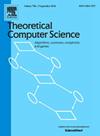The Exact Subset MultiCover problem
IF 0.9
4区 计算机科学
Q3 COMPUTER SCIENCE, THEORY & METHODS
引用次数: 0
Abstract
In this paper, we study the Exact Subset MultiCover problem (or ESM), which can be seen as an extension of the well-known Set Cover problem. Let be a multiset built from set and function . ESM is defined as follows: given and a collection of n subsets of , is it possible to find a multiset with and , such that (i) for every , and (ii) each element of appears as many times in as in ? We study this problem under an algorithmic viewpoint and provide diverse complexity results such as polynomial cases, NP-hardness proofs and FPT algorithms. We also study two variants of ESM: (i) Exclusive Exact Subset MultiCover (EESM), which asks that each element of appears in exactly one subset of ; (ii) Maximum Exclusive Exact Subset MultiCover (Max-EESM), an optimization version of EESM, which asks that a maximum number of elements of appear in exactly one subset of . For both variants, we provide several complexity results; in particular we present a 2-approximation algorithm for Max-EESM, that we prove to be tight. For these three problems, we also provide an Integer Linear Programming (ILP) formulation.
精确子集多重覆盖问题
本文研究的是精确子集多覆盖问题(或称 ESM),它可以看作是著名的集合覆盖问题的扩展。设 (U,f) 是由集合 U={e1,e2,...em} 和函数 f:U→N⁎ 构成的多集。ESM 的定义如下:给定(U,f)和由 U 的 n 个子集组成的集合 S={S1,S2,...,Sn},是否可能找到一个多集合(S′,g),其中 S′={S1′,S2′,...,Sn′}和 g:S′→N,使得 (i) Si′⊆Si,且 (ii) U 的每个元素在 (U,f) 中出现的次数与在 (S′,g)中出现的次数一样多?我们从算法的角度研究了这个问题,并提供了多种复杂性结果,如多项式情况、NP-hardness 证明和 FPT 算法。我们还研究了 EESM 的两个变体:(i) Exclusive Exact Subset MultiCover (ESM),要求 U 的每个元素都恰好出现在 S′ 的一个子集 Si′中;(ii) Maximum Exclusive Exact Subset MultiCover (Max-EESM),这是 EESM 的优化版本,要求 U 的最大数量的元素恰好出现在 S′ 的一个子集 Si′中。对于这两个变体,我们都提供了一些复杂度结果;特别是,我们提出了一个最大 EESM 的 2 近似算法,并证明了它的严密性。对于这三个问题,我们还提供了整数线性规划(ILP)公式。
本文章由计算机程序翻译,如有差异,请以英文原文为准。
求助全文
约1分钟内获得全文
求助全文
来源期刊

Theoretical Computer Science
工程技术-计算机:理论方法
CiteScore
2.60
自引率
18.20%
发文量
471
审稿时长
12.6 months
期刊介绍:
Theoretical Computer Science is mathematical and abstract in spirit, but it derives its motivation from practical and everyday computation. Its aim is to understand the nature of computation and, as a consequence of this understanding, provide more efficient methodologies. All papers introducing or studying mathematical, logic and formal concepts and methods are welcome, provided that their motivation is clearly drawn from the field of computing.
 求助内容:
求助内容: 应助结果提醒方式:
应助结果提醒方式:


